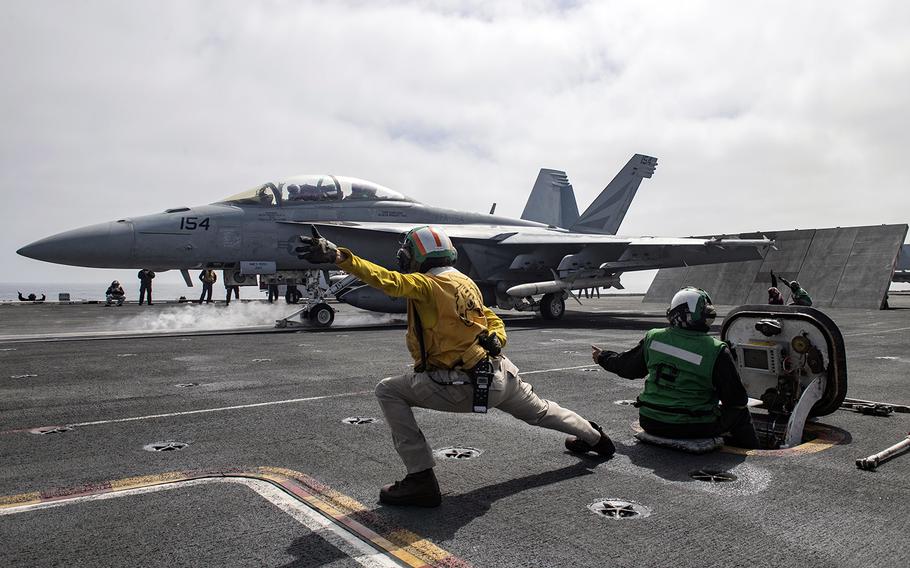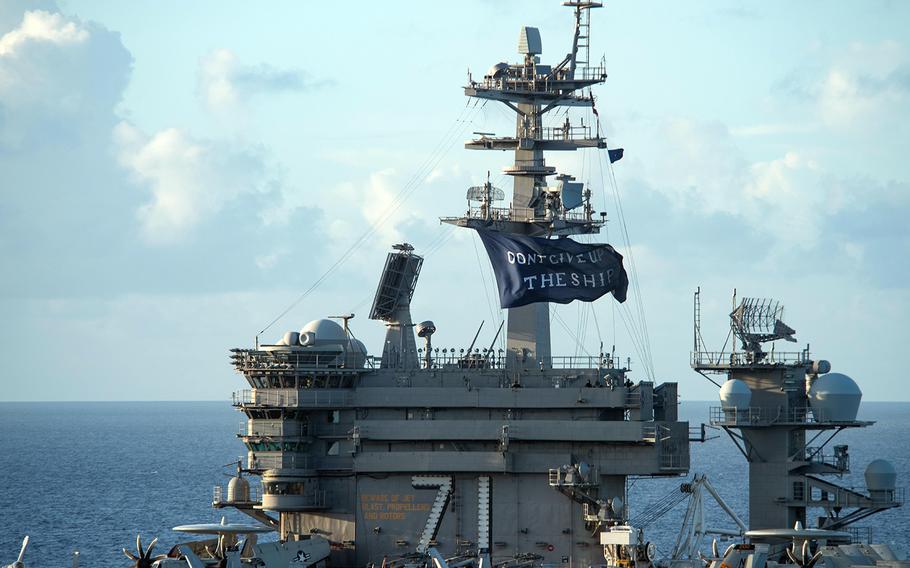
An F/A-18F Super Hornet assigned to the Black Knights of Strike Fighter Squadron 154 launches from the flight deck of the aircraft carrier USS Theodore Roosevelt somewhere in the Pacific Ocean, July 7, 2020. (Dylan Lavin/U.S. Navy)
The aircraft carrier USS Theodore Roosevelt is returning home to San Diego after a fateful six-month deployment scarred by a coronavirus outbreak, a leadership crisis and the loss of two sailors.
Its commander, Capt. Carlos Sardiello, in a post on the ship’s official Facebook page Wednesday, reflected on how far the warship has come in half that time.
“As we near the end of this deployment I can't help but smile a little with a feeling of serenity, reflecting on where we were three months ago and where we are now,” he wrote. “When the world needed heroes, you stepped up and filled that place.”
More than 1,150 Roosevelt sailors tested positive for the coronavirus and one died from the illness after an outbreak aboard the ship that started March 24, according to a Navy investigation published in May. The carrier then diverted to Guam, where it stayed for more than two months to sanitize the ship and disembark, isolate, test and treat sailors.
The lone fatality from the outbreak, Chief Petty Officer Charles Thacker Jr., 41, of Fort Smith, Ark., died April 13 and was buried Wednesday in Fort Smith National Cemetery, according to the Southwest Times Record newspaper.
Though the patrol was marred by the outbreak, Sardiello in his Facebook post said his crew “fulfilled the promise,” and that “hope and inspiration comes from you onboard here.”
“You were my heroes before, you are my heroes now and your recovery in the face of adversity makes this arguably one of USS Theodore Roosevelt's finest hours of which you should be very proud,” he wrote.

The aircraft carrier USS Theodore Roosevelt flies a "Don't Give Up the Ship" flag in the Philippine Sea, June 3, 2020. (Will Bennett/U.S. Navy)
The Roosevelt returned to sea on June 4. Two weeks later, on June 18, one of its F/A-18F Super Hornets crashed into the Philippine Sea. The pilot and weapons officer were rescued by helicopter.
As the carrier steamed toward home, another sailor died on board, this time of an undisclosed medical emergency on July 2. The Navy identified him as Chief Petty Officer Justin Calderone, an aviation electronics technician, husband, father of three and Ohio native.
Before journeying home, the Roosevelt also trained with the USS Nimitz on June 21 in the Navy's first dual-carrier exercise in the Western Pacific since 2018.
Sardiello did not say exactly when the Roosevelt would pull back into its homeport, Naval Base San Diego, but two ships from the strike group — guided-missile destroyer USS Russell and guided-missile cruiser USS Bunker Hill — returned on Wednesday, according to a Navy statement.
The Navy as policy does not discuss future ship movements, citing operational security.
Sardiello took over for Capt. Brett Crozier, the carrier’s previous commander, when then-acting Navy Secretary Thomas Modly removed Crozier from command in April. The move came after a letter Crozier sent to Navy higher-ups pleading for help for his crew was leaked to the San Francisco Chronicle.
“The spread of the disease is ongoing and accelerating,” he wrote March 30. “We are not at war. Sailors do not need to die.”
The backlash against Modly from sailors and lawmakers for removing Crozier was swift. Video of thousands of Roosevelt sailors chanting Crozier’s name as he walked off the carrier for the last time flooded social media.
Modly resigned about a week after removing Crozier when a recording of his speech to the Roosevelt’s crew criticizing the former skipper and calling him “too naive or too stupid” was leaked to the public.
The episode spurred Chief of Naval Operations Adm. Mike Gilday to order a full investigation into the outbreak’s handling. While Gilday initially said he would reinstate Crozier as commander, the investigative report revealed Crozier had mishandled parts of the response.
“Had I known then what I know today, I would have not made that recommendation to reinstate Capt. Crozier,” Gilday told reporters on June 19. “Moreover, if Capt. Crozier were still in command today, I would be relieving him.”
For example, Crozier kept sailors on board the ship longer than necessary when he would not release them to cots made available in warehouses and storerooms ashore because they “were not single occupancy,” according to the report. Instead, thousands of sailors remained in cramped conditions aboard the carrier until hotel rooms were secured.
Gilday told the reporters that Crozier’s “determination that onboard quarantine was ineffective should have led to an acceleration of sailors to ashore accommodations. It did not.”